| Next > |
|---|
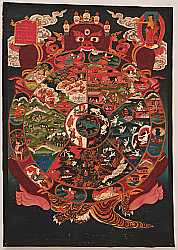 A Bhavacakra is a Buddhist iconographic pattern that you can find frequently on thangka paintings (religious Buddhist scrolls) or on murals at the entrance of Buddhist monasteries.
A Bhavacakra is a Buddhist iconographic pattern that you can find frequently on thangka paintings (religious Buddhist scrolls) or on murals at the entrance of Buddhist monasteries.
Bhavacakra are known under a number of different names, not just this tongue breaker. The most common name is 'wheel of life'. Other names are 'cycle of rebirths', 'wheel of becoming' or - rare - Devanagari (from Sanskrit).
Bhavacakra - The Pauper's Buddhist Bible
In more popular publications you can find the expression 'The Pauper's Buddhist Bible' to recap the quintessence of a Bhavacakra. And this is precisely what it is. Basically a kind of wrap-up of the basics of the Buddhist belief.
To understand the Bhavacakra, let us first wrap-up the essentials of Buddhism in a few, simple words. Then let us take a look how the different parts of a Bhavacakra thangka represent the fundamentals of the teachings of the historical Buddha some 2,500 years ago.
Gautama Siddhartha - the Founder of Buddhism
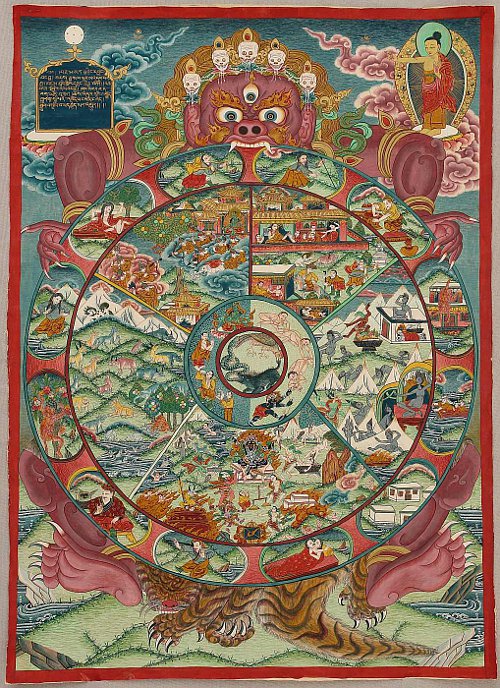
The man the world knows today as Buddha, did actually exist on earth. He was born around 563 BC in Lumbini in Southern Nepal as the son of an emperor over a small Indian kingdom. He was born under the name Gautama Siddhartha and became the founder of Buddhism.
Desires, the Source of Suffering
Buddhism is basically all about suffering and how to overcome suffering as an individual. The young Gautama Siddhartha one day found out that the world was more than the plush environment of his father's royal palace and the pleasant court life surrounding him every day. He saw that there was illness, aging and death.
But even if we as human beings live under quite acceptable conditions, we usually suffer, not just in a physical way. We constantly have desires, wishes, cravings to get or achieve this and that, and always more. And as a consequence we feel dissatisfied and unhappy. In a nutshell, we suffer.
How to End all Suffering
Gautama Siddhartha left his father's palace and became a wandering monk. It took him 6 years until he finally would discover not only the reasons for our suffering but also a way how to end it. This moment is called the Buddha hood, becoming the Buddha, enlightenment or transformation to nirvana. Or in other words, it is the total understanding of the mechanisms of this world, the ultimate bliss and goal for every Buddhist. When Gautama Siddhartha reached enlightenment, he was 35 years old. He spent the rest of his life teaching his findings in Northern India.
The Way to Enlightenment
Early Buddhism is more a philosophy than a religion. There are no saints or gods. Buddha did not regard himself as a god, nor does the present 14th Dalai Lama ("I am an ordinary monk and a teacher."). Buddha saw the world as a system of causes and effects. All actions result in an effect. This concept is called Karma.
Buddha saw the individual as responsible for himself. And the way to enlightenment, and thus the end of suffering, was by bearing a morally good and responsible life. Good actions and behavior result in positive effects for yourself and bring you forward in the right direction towards nirvana.
The Concept of Rebirths
Gautama Siddhartha took the belief in rebirths (reincarnations) from Hinduism and integrated it into his beliefs. A good karma does not immediately take you to nirvana. In early Buddhism it is rather a long way to go via many cycles of rebirths. Gautama Siddhartha is believed to have had a few hundred rebirths before he finally found enlightenment and thus the end of suffering.
And now comes the trick. Your karma decides over the quality of your next rebirth. Or in other words, if you do positive things in your current life, you will have a better next life - and vice versa.
The above is all a bit simplified, of course, and represents the early type of Buddhism. Later forms introduced an army of benign little helpers, called Bodhisattvas and other deities, saints and forms of devotion to shorten and alleviate the way to nirvana.
Bavacakra
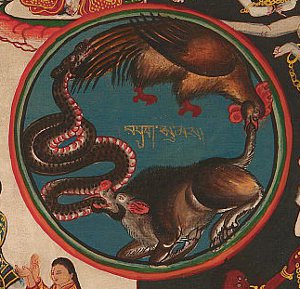 Now let us go back to our Bavacakra and see how this Buddhist view of life is represented in this ensemble of fundamental motifs.
Now let us go back to our Bavacakra and see how this Buddhist view of life is represented in this ensemble of fundamental motifs.
The inner circle shows a pig, a cock and a serpent who hold each other by their tails - to express that these evils are all interconnected to each other. Together they represent the cause of suffering.
Why three? Above I mentioned only desire. The Buddha's teachings speak of The Three Poisons - lust, hatred and greed. In a wider sense, these are all 'desires'. Buddhism is a highly abstract concept that is often easier to explain to Western minds by abstract synonyms than by Eastern symbolism.
Inner Circle
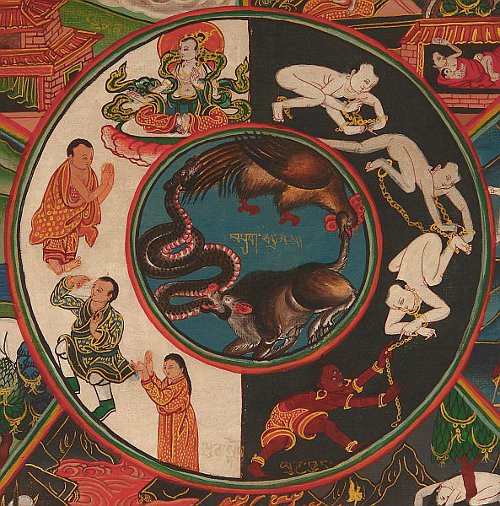
The inner circle shows to the left the white path of bliss, where human beings with a good karma move upwards towards a positive rebirth. On the right side is the dark path. It is here where people with a bad karma fall down to a negative rebirth.
The Realms
The center of the wheel shows five or six sections in a kind of a form of a piece of cake. These are the realms or kingdoms. They represent the different conditions of reincarnations (rebirths). The better ones are on top, and the bad ones on bottom.
Early Buddhism knew 5 of these realms. The Tibetan Buddhism expanded it later to 6. But that is not really important. Buddhism is not a dogmatic religion. Let us rather take a closer look at these different realms or spheres or worlds or kingdoms as they are called.
World of the Gods
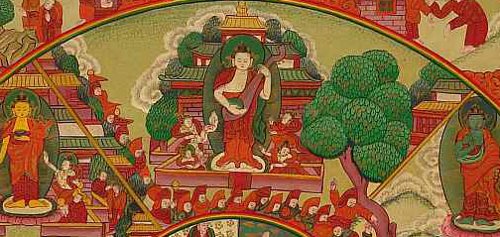
From a superficial view, the world of Gods looks like a pretty pleasant place to spend one's time. The great danger here is to rest on one's laurels. It is not yet paradise. Nirvana has not yet been achieved, and by accumulating bad karma one could fall back into a lower realm in one's next life.
World of the Titans
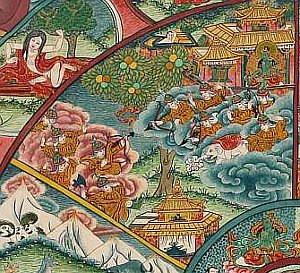 The world of the titans and semi-gods is dominated by a futile strife for the fruits of the tree of wishes. They fight each other with bows and arrows and spears.
The world of the titans and semi-gods is dominated by a futile strife for the fruits of the tree of wishes. They fight each other with bows and arrows and spears.
World of the Humans
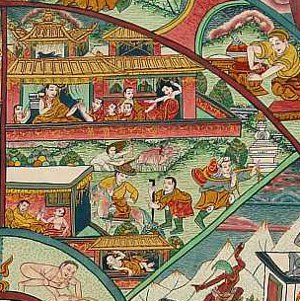
The world of humans shows scenes of typical activities of us human beings. In this realm the painters usually show old age, sickness and death as typical forms of human suffering.
World of the Animals
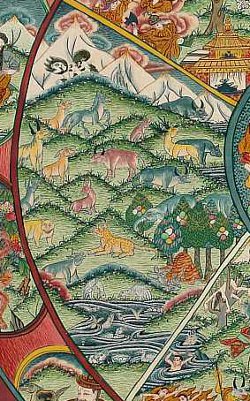
The destiny of most animals is to be used, and often misused by humans. And animals kill other animals. This realm is characterized by ignorance. Buddhism is not about humans only, but includes the animals.
Just a personal remark: Up to this day, it is unclear for me how 'karma' shall work for animals.
World of Hungry Spirits
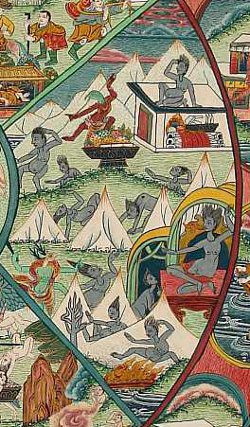
The hungry spirits are called Pretas. Their mouths and throats are so minuscule that they cannot take food. This realm represents greed.
World of Hell
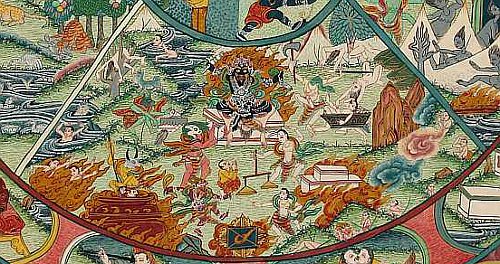
The world of hell looks gruesome like a painting by Hieronymus Bosch. People are tormented in the most deplorable ways. The death god Yama is sitting on a pedastal holding a mirror that shows the delinquents their evils. A servant of Yama weighs the good deeds against the bad ones. The good deeds have the color white and the bad deeds are painted in black.
The Twelve Nidanas
The outer ring shows the twelve nidanas. These symbolize the chain of causation and effect. This is a difficult subject. When it comes to explaining the 'nidanas' the books that I know resort to wishy-washy.
Personally, I have never had the feeling that I really ever understood it. I think it is better to leave it out. The whole concept of Bavacakra can - in my humble opinion - be understood well and appreciated without the consideration of this outer circle.
Who is that Funny Monster?
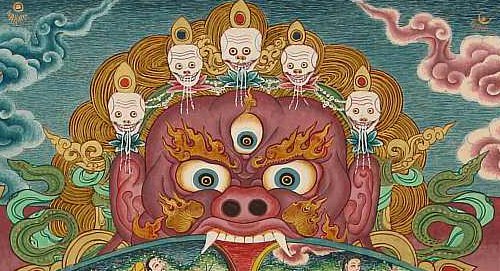
The whole wheel is held in the claws and fangs of a funny looking monster. Apparently nobody knows who is meant. Guesses are from Yama, the ruler of hell to Mahakala or the Demon Mara.
But that is not important either. It is one of the positive aspects of Buddhism. Nobody would start a dogmatic schism over that question, let alone kill each other by the thousands, as the Christians did.
Bhavacraka Thangkas in our Shop
If you are interested in seeing more thangkas with the Bhavacakra motif, take a look at our thangka shop.
Dieter Wanczura, September 2010.







